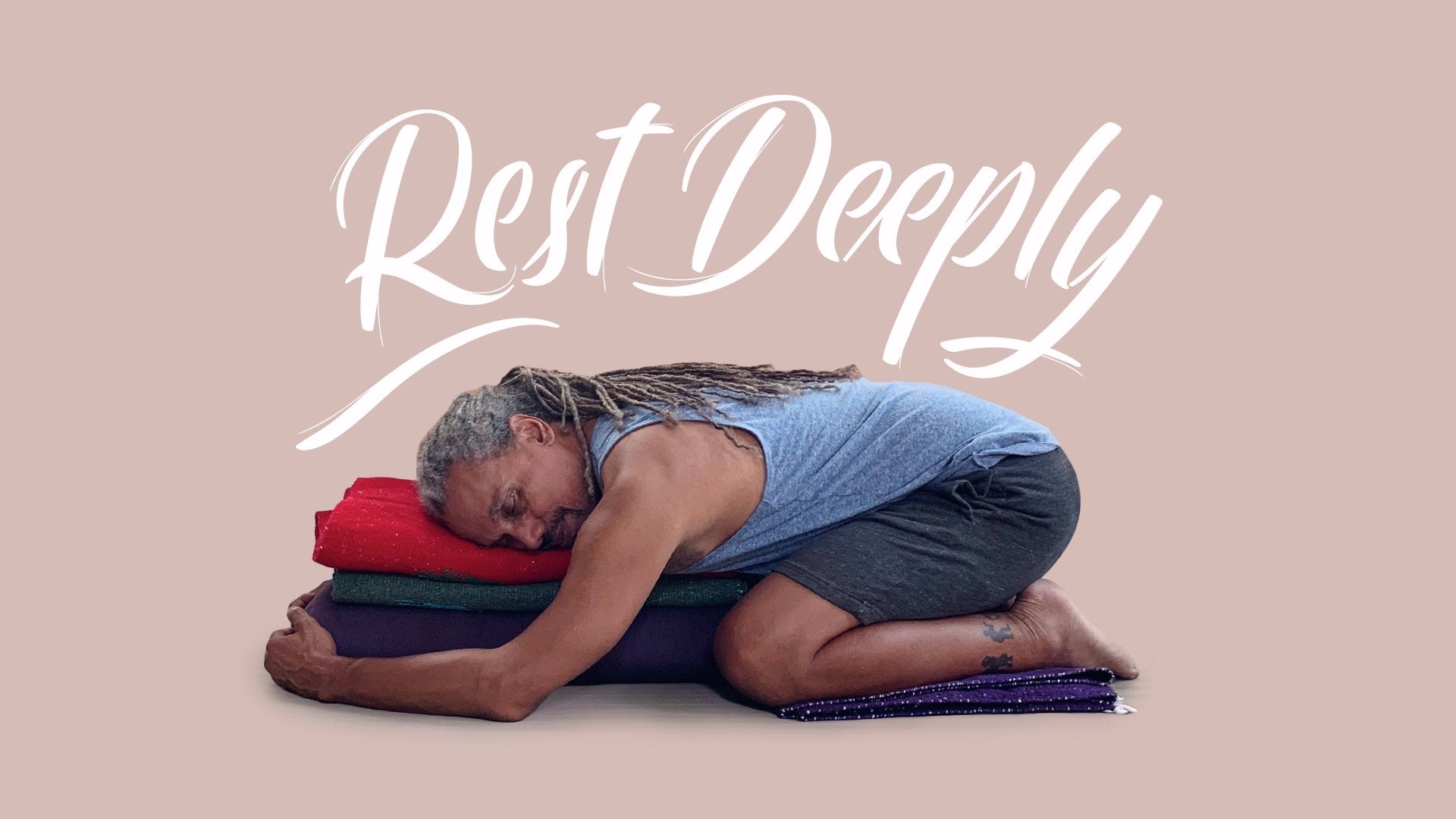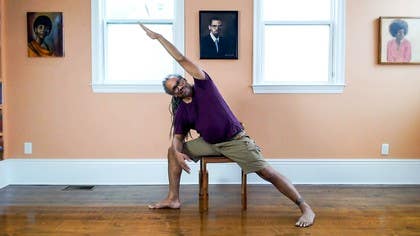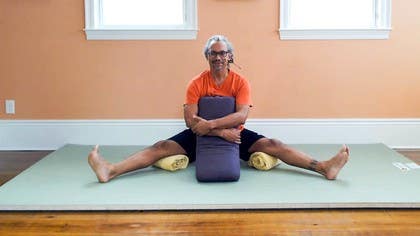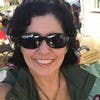Description
About This Video
Transcript
Read Full Transcript
Hi, so in this class we're going to explore the liver and gallbladder chi and movement that is associated with the liver and gallbladder meridians. In Chinese medicine, liver and gallbladder compromise the wood element and together they're responsible for the smooth flow of chi or energy in the body, blood, and also the smooth movement of emotions. And all of those things together, blood, chi, and emotions, all are completely intertwined with each other in Chinese medicine. So if the blood becomes stagnant, that will also make the chi the energy stagnant and it will also make the emotion stagnant. Same thing versus vice, if the emotions get stagnant as in they're not expressing and they're not moving, it will also make the blood stagnant and the chi the energy stagnant.
The best treatment, better than any needles or herbs or even dietary changes, the best treatment for liver-chi stagnation is to move all the layers, move the physical body, move the energetic body, and to let the emotional body move as well. So where they're located up the inside of the leg is where the liver meridian is coming up from the inside of the leg, up the core of the body, and then it crisscrosses across the ribs. And the gallbladder meridian is starting here at the side of the head, crisscrossing along the side of the head, coming down the neck, and then also crisscrossing across the ribs and going down the outside of the body. So we'll be focusing on those areas to help facilitate the movement of chi, blood, and emotions. Let's start off with a little self-massage.
I'm going to take one hand out to the side and take my other hand to the low ribs with the flats of the fingers. I don't want to use my fingertips. So imagine you have long nails. You want to use the pads of the fingers. And I'm going to hold my arm up just so you can see, but you can do this with your arm relaxed down.
It's fine. And you're going to draw circles, feeling in to the ribs on the side of the body. This is an area that doesn't often get massaged. It's kind of challenging to stretch this whole side plane of the body. So if you find a spot that feels a little tender, you're going to press it with your fingers and then take the elbow on that side and reach it up towards the ceiling and lean away.
You may need to take your feet a little wider so you have a solid base and lean away so that you're stretching what you're compressing with your fingers and then come back up. And it's helpful to breathe to inhale as you come up, as you tip over, that is, and exhale as you come back up, inhale, and exhale. And one thing that's really important to remember about the ribcage, the ribs are bones, but the bones are really bendy and flexible. And we often forget that these bones are really bendy and we want to keep them moving. I like to think of the ribcage kind of like an accordion, right?
If I had an accordion this way, I could open it to make a sound this way, I can open it the other way. I'm going to open the side of my accordion like ribcage and get the ribs to fan open. I'm going to come back to center, find another spot, want to feel bones, the rib bones under my fingers and then tip away. I can either rest my hand on my head or you can reach your arm to tip over and come back down and then find a third point. Oh, that's a good one.
Right there. That's a tender one. I'm going to reach my hand up. If it hurts to have your arm straight, you can bend your elbow, it's less weight on the shoulder and then tip over. Yeah, and breathe.
It's always good. And come back up and relax your hands at your sides. That's a lot of work for the fingers that are doing the squishing, but if you do it a little bit every other day or so, your hands get quite a bit stronger. Let's do the other side. Again, I'm going to hold my arm out just for visual purposes.
You can leave your arm relaxed down. And one nice thing about doing this on yourself is it's really hard to do this on somebody else because of ticklishness, but usually it's very challenging to tickle yourself. Ooh, find a spot and then reach the elbow up. Come back. Find another spot.
And if your shoulder is fine, you can reach the arm way up overhead and come over to the side. And come back up. And then bring your feet in just a little bit, hands on your knees. We're going to take the ribs and move the ribs forward and back. So inhale a little bit of a cat cow feeling here.
Inhale arching the low back, lifting the heart, looking up. When you look up, keep your neck in line with the rest of the spine. So don't just drop your head back. Ooh, that's really hard on the neck. Just lift the heart and lift the gaze as much as is easy.
And then as you exhale, tuck the tailbone and lean back. Now if you run into the chair right away, just scoot a little more towards the edge of the chair. Inhale lift up, shoulders stay down away from your ears. Exhale round forward. You can do this practice in pretty much any chair.
I always am doing yoga and, well, really long flights on the airplane. I have to be careful about not leaning into my neighbor. One more. Inhale lengthening, arching. Exhale back to the center.
Let's take one leg out to the side and then take the other leg back the opposite way with the foot flat on the floor. Sitting up here, oh, I also have a block here. I'm going to bring my block over to this side in case I need it or want it. So here I'm in position to do Warrior II. I can hang out here in Warrior II, either looking over the front fingertips or if that's hard in my neck, I can just look straight ahead.
And again, if this is hard on the shoulders, bending the elbows takes a lot of weight out of the shoulders. I can just imagine that I'm extending out my elbow tips. Inhale here. And as you exhale, you're going to tilt over towards that leg. You can bring your hand to the leg, your elbow to the leg, or you can bring your hand down to the block.
And some of you may even want to bring your fingertips to the floor. Just find what works for you. The side you're leaning away from, reach that elbow or arm towards the ceiling. And then maybe up past your ear with the arm or with the elbow. Oh yeah, and breathing is always good here.
Next exhale, bring that lifted arm down and come up to sitting and turn to face your front foot and come on to the ball of the foot of the back leg. I need to scoot a little more towards the front side of my chair so that I can have free movement with the back leg. And then I'm going to lean forward and place my elbows on the leg. I could bring my hands all the way down to the floor and come into this low lunge. I could also come up to the block, but for me, my body feels a little better right here.
And then reaching back with the back heel and breathing, about three breaths here. And then lifting the heart, lifting the head. So your torso comes pretty much straight up and down and still pressing back with the back leg. Hopefully you're feeling a stretch in the iliopsoas muscle on the front side of the hip. This is the main hip flexor muscle.
And since we're spending so much time, more and more time every year, it seems, sitting at a computer or sitting in front of the TV, we do a lot of sitting, sitting, sitting. And we need to do the opposite to lengthen the iliopsoas. It'll make our soas happier, which will make our back happier. Just down away from the ears, one more breath here. And then turning back slowly towards the front.
I'm going to move my block over to the other side. Inside the opposite leg open, scooting a little forward, and then taking the back foot back, but keeping the foot flat on the floor, coming into position for warrior two, whatever variation works best for your body. You can also, if bringing the arms up parallel to the floor is hard on the shoulders, you can drop the shoulders down a little bit. You're the one inside your body. You're the one who knows best what works for you.
I always think about high school gym class, no gain, no pain. That's not yoga. You're better off to find your own yumminess in your poses, in your practice. And we're going to tip forward, either onto the elbow, onto the block, or down to the floor, the back hand, either reaching up with the hand or the elbow, and finding what works for you. Right here, we're really stretching that liver and gallbladder playing on the lateral body.
We're also stretching the liver meridian on the inner thighs, and breathe. Inhale your way up. We're going to turn to face our front leg, and come onto the ball of the back foot. And then come forward, either forearms to the leg, or hands down to the floor, or block. For me, forearms to the leg feels best.
Then the back leg, I want to press back through the back heel. I'm not only getting a fantastic calf stretch, but I am starting to get a little stretch here in the psoas. Just a little. We'll add a little bit more as we sit up tall. Oh, that's a great calf stretch.
If you were to count how many repetitions you do every day with your calf muscles every step, how much work they do when they're standing, when you're standing and balancing, they do a lot of work, and they're kind of underpaid. So giving them a stretch is really nice. Go ahead and lift the heart up, sitting up tall, still pressing back through the back heel. Now probably getting a little bit more of this ileo psoas stretch, a nice counter pose for sitting and breathing. Then turning back towards the center, bringing the feet down to the mat, bringing the feet in and just take a pause here and breathe.
Breathe a little awareness into the sides of the body, the sides of the ribs, and the inner thigh where the liver meridian runs, right up through the psoas. We're going to do the psoas stretch again and add a little extra frosting on top of it. So open out one side, and we're going to come right into the high lunge position on the chair, pressing back with the heel to start to feel this stretch, and breathe. You have quite a bit of pressure into the front foot, pressure back through the back heel, then whichever leg is in back, you're going to take that arm and sweep it up towards the ceiling and bend the elbow as if you were trying to scratch between your shoulder blades. Now reach up through the elbow and maybe arch back just a little bit.
You'll feel how the arm fascia is connected to the hip fascia. All the connective tissue is interconnected, and they literally are connected to each other. The fascia is a continuous substance throughout the body. Picking with your breathing here, still actively pressing back through the back heel, and the next inhale, come up and release the arm, and slowly bring the leg in and turn back to the front. The psoas is understretched, just like our calf muscles, so I like to do a little bit of psoas work every day, turning to the other side, front foot planted, shin basically vertical, and then pressing back through the back heel, heart turned forward.
Get a solid base so you could, somebody theoretically could just slide the chair out from under you, but don't do that. But you're strong here in your base. Then whichever leg is in back, take that same arm, reach it up overhead, and bend the elbow trying to scratch that spot between your shoulder blades. And from here extend up the elbow, like somebody is lifting your elbow towards the ceiling, and maybe arch back just a little uch, and breathe. Next inhale, sitting up tall, releasing the arm, releasing the legs, turning back forward to center, and take a pause.
As you pause, feel into the sides of the ribs, feel into that inner thigh where the psoas is, psoas coming all the way up into the front side of your lumbar spine, the front side of your low back, behind your organs. Open your eyes, we're going to bring one knee up towards the chest, cross the ankle over, and then we want to find a point here. I'm going to do that circling, so the pads of the fingers circling, and I want to feel these long bones in the top of the feet. There's one in line with the big toe, and one in line with the second toe. I want to find the space right in between those, the space right in between those.
And slowly I'm going to delicately dig in there. It can be quite tender, so you just do the amount of pressure where you become aware that there's a spot right there, there's a point right there. Don't hurt yourself, don't bruise yourself, be nice to yourself. And draw some circles on that point. This is one of the most important points in acupuncture and acupressure, it's liver 3.
It's considered one of the biggest qi and blood moving points in the body, and just hold that point with a steady pressure and breathe. And then release that point, we're going to stay in this cross position, inhale, sit up tall, you might already be feeling a hip stretch out here, just sitting up tall, if so, hang out there, if not, as you exhale, you can tilt forward a little bit, and some of you may be able to flop your chest down all the way to your leg. We still love you, but some of us are quite a bit more stable in the hips. Just going for a hip stretch out here right now, getting that outer hip stretch is a really important gallbladder point. It's where the gallbladder and the bladder meridian intercross, and is a very important point in treating low back pain, for example, with either needles or with acupressure.
Inhale yourself up, bring your knee into your chest and uncross the leg, and then set it down. Bring the other knee in and cross the leg, and we're going to find the point on this side, so here's the big toe, and there's this bone right here, metatarsal, and here's the second toe, and I want to go into this space in between, so if I circle, I'll find that little space, and this is one place where you can kind of use your fingertips. If you have nails, use the edge of your finger, and smoosh around on tender points, oh goodness. This is one of the points in acupuncture, where they say it's got a dot chi, it's got big chi, big energy, when you find the point, it's a big sensation, and take a couple of breaths, and then release the foot. I'm going to sit up tall here, and as we start to get a little arch in the low back, you might already start to feel it in this hip of the crossed over leg.
You can hang out here, or you can start to tip forward until you feel a little outer booty stretch, and breathe, really important to breathe in this version. This is basically the seated version of thread the needle pose. Inhale your way up, bring the knee in towards the chest, uncross, and set the foot down. We're going to come into our final relaxation, and you're welcome to take it in the chair. If you're going to take it in the chair, you can lean back a little bit, but you can also lie down if you have a yoga mat, or a soft floor with a couch cushion, or a head pillow, something like that.
Getting comfy is really important. For the first few breaths of the Shavasana, I'm going to lean back into the support of my chair, or lean into the floor, and I'm going to, again, bring awareness to the sides of the body, sides of the ribs, the outsides of the legs for the gallbladder meridian, the insides of the thighs for the liver meridian, and we can just imagine that as you inhale, you inhale up the inner thighs, up across the ribs, and as you exhale, you exhale down the ribs, the outer hip, and down the outer thighs. So I'm just going to draw my hands. You don't have to do this, or you can, if you like, inhale the inner thighs, across the ribs, exhale down the outer ribs, outer thighs, and down the leg. Energy follows intention.
So when you bring your intention to moving your energy, it will move. And moving the energy also includes moving the blood, and moving the emotions, because they are intertwined. If you find yourself holding back an emotional expression, if you're in a safe place, why not let it move, let that energy move, let your breath move, let your body move. Your liver chi will thank you. You can let go of the effort with the breath.
If you haven't closed your eyes, let them close. Follow the natural movement of your breath, in and out, your breath moving across the layers of your being, the way the ocean moves in and out across the beach, smoothing away the roughness, carrying away whatever is ready to move and be released, and bringing nourishment, moisture, life into all the layers of your being. You're welcome to stay in your shavasana, but if you're ready to come out of the practice, you can deepen your breath, and bring a little movement, breathe a little movement into your toes and fingers. If you're down on the ground, you can slowly roll your way to one side. If you're sitting in a chair, you can start to sit up slightly, move the ribs a little bit.
If you're down on the ground, you can come up to a seated position, and then bringing your palms together, hands in front of your heart. Namaste.
Rest Deeply
Comments
You need to be a subscriber to post a comment.
Please Log In or Create an Account to start your free trial.















